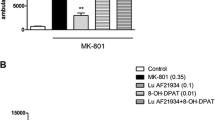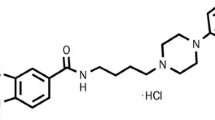Abstract
Rationale
Aripiprazole (OPC-14597) is a novel atypical antipsychotic drug with a low incidence of side effects. The therapeutic action of aripiprazole has been attributed to its unique agonist/antagonist effects at D2 dopamine receptors; however, aripiprazole also has significant in vitro affinity at 5-HT1A receptors.
Objectives
The 5-HT1A agonist property of aripiprazole has so far not been evaluated in any in vivo assay.
Methods
Thirteen male Sprague Dawley rats trained to discriminate the 5-HT1A agonist LY 293284 (75 nmol/kg) from saline, using a fixed ratio (FR) 50 schedule of food-reinforcement in a two-lever operant-conditioning task, were used to evaluate the behavioral effect of aripiprazole at 5-HT1A receptors.
Results
Aripiprazole fully mimicked LY 293284 in a drug-discrimination assay with an ED50 of 1.39 μmol/kg (0.62 mg/kg). In combination tests, aripiprazole did not block the LY 293284 cue but at 8.92 μmol/kg (4 mg/kg) significantly reduced the response rate by lowering the threshold for induction of the 5-HT syndrome produced by the training dose of LY 293284. Moreover, the selective 5HT1A receptor antagonist WAY 100635 was able to block the substitution of aripiprazole in LY-293284 trained rats.
Conclusion
Although the efficacy of aripiprazole against the positive symptoms of schizophrenia may be related to its dopamine receptor interactions, it seems possible that its atypical profile may derive, at least in part, from its 5-HT1A agonist effect, rather than from unusual D2 receptor properties.

Similar content being viewed by others
References
Ahlenius S (1988) Antipsychotic-like properties of the 5-HT1A agonist 8-OH-DPAT in the rat. Pharmacol Toxicol 64:3–5
Andersen HL, Kilpatrick IC (1996) Prevention by (±)-8-hydroxy-2-(di-N-propylamino)tetralin of both catalepsy and the rises in rat striatal dopamine metabolism caused by haloperidol. Br J Pharmacol 118:421–427
Assie MB, Cosi C, Koek W (1997) 5-HT1A receptor agonist properties of the antipsychotic, nemonapride: comparison with bromerguride and clozapine. Eur J Pharmacol 334:141–147
Bantick RA, Deakin JF, Grasby PM (2001) The 5-HT1A receptor in schizophrenia: a promising target for novel atypical neuroleptics? J Psychopharmacol 15:37–46
Bervoets K, Millan MJ (1993) 5-HT1A receptors and the tail-flick response. V. Opposite modulation of 5-HT1A receptor-induced spontaneous tail-flicks by α1A- as compared with α2D-adrenoceptors in rat lumbar spinal cord. J Pharmacol Exp Ther 269:110–120
Broekkamp CLE, Oosterloo SK, Berendsen HHG, van Delft AML (1988) Effect of metergoline, fenfluramine, and 8-OH-DPAT on catalepsy induced by haloperidol or morphine. Naunyn Schmiedebergs Arch Pharmacol 338:191–195
Burris KD, Molski TF, Xu C, Ryan E, Tottori K, Kikuchi T, Yocca FD, Molinoff PB (2002) Aripiprazole, a novel antipsychotic, is a high-affinity partial agonist at human dopamine D2 receptors. J Pharmacol Exp Ther 302:381–389
Christoffersen CL, Meltzer LT (1998) Reversal of haloperidol-induced extrapiramidal side effects in cebus monkey by 8-hydroxy-2-(di-N-propylamino)tetralin and its enantiomers. Neuropsychopharmacology 18:399–402
De Vry J (1995) 5-HT1A receptor agonists: recent developments and controversial issues. Psychopharmacology 121:1–26
Donohoe TP, Hutson PH, Curzon G (1987) Blockade of dopamine receptors explains the lack of 5-HT stereotypy on treatment with the putative 5-HT1A agonist LY 165163. Psychopharmacology 93:82–86
Egan CT, Herrick-Davis K, Miller K, Glennon RA, Teitler M (1998) Agonist activity of LSD and lisuride at cloned 5-HT2A and 5-HT2C receptors. Psychopharmacology 136:409–414
Egan CT, Grinde E, Dupre A, Roth BL, Hake M, Teitler M, Herrick-Davis K (2000) Agonist high and low affinity state ratios predict drug intrinsic activity and a revised ternary complex mechanism at serotonin 5-HT2A and 5-HT2C receptors. Synapse 35:144–150
Elliot J, Reynolds GP (1999) Agonist-stimulated GTPγ[35S] binding to 5-HT1A receptors in human post-mortem brain. Eur J Pharmacol 386:313–315
Ferre S, Artigas F (1995) Clozapine decreases serotonin extracellular levels in the nucleus accumbens by a dopaminereceptor-independent mechanism. Neurosci Lett 187:61–64
Foreman MM, Fuller RW, Rasmussen K, Nelson DL, Calligaro DO, Barrett JE, Booher RN, Paget CJ, Flaugh ME (1994) Pharmacological characterization of LY 293284: a 5-HT1A receptor agonist with high potency and selectivity. J Pharmacol Exp Ther 270:1270–1281
Forster EA, Cliffe IA, Bill DJ, Dover GM, Jones D, Reilly Y, Fletcher EA (1995) A pharmacological profile of the selective silent 5-HT1A receptor antagonist, WAY-100635. Eur J Pharmacol 281:81–88
Fujikawa M, Nagashima M, Inoue T, Yamada K, Furukawa T (1996) Partial agonistic effects of OPC-14597, a potential antipsychotic agent, on yawning behavior in rats. Pharmacol Biochem Behav 53:903–909
Goodnick PJ, Jerry JM (2002) Aripiprazole: profile on efficacy and safety. Expert Opin Pharmacother 3:1773–1781
Hashimoto T, Nishino N, Nakai H, Tanka C (1991) Increase in serotonin 5-HT1A receptors in prefrontal cortex and temporal cortices of brains from patients with chronic schizophrenia. Life Sci 48:355–363
Hillegaart V, Magnusson O, Ahlenius S (2000) A9 and A10 dopamine nuclei as a site of action for effects of 8-OH-DPAT on locomotion in the rat. Pharmacol Biochem Behav 67:55–63
Hutson PH, Donohoe TP, Curzon G (1987) Neurochemical and behavioural evidence for an agonist action of 1-[2-(4-aminophenyl)ethyl]-4-(3-fluoromethylphenyl) piperazine (LY 165,163) at central 5-HT receptors. Eur J Pharmacol 138:215–223
Inoue T, Domae M, Yamada K, Furukawa T (1996) Effects of the novel antipsychotic agent 7-{4-[4-(2,3-dichorophenyl)-1-piperazinyl]butyloxy}-3,4-dihydro-2(1H)-quinolinone (OPC-14597) on prolactin release from the rat anterior pituitary gland. J Pharmacol Exp Ther 277:137–143
Invernizzi RW, Cervo L, Samanin R (1988) 8-Hydroxy-2-(di-N-propylamino)tetralin, a selective serotonin1A receptor agonist, blocks haloperidol-induced catalepsy by an action on raphe nuclei medianus and dorsalis. Neuropharmacology 27:515–518
Jordan S, Koprivica V, Chen R, Tottori K, Kikuchi T, Altar CA (2002) The antipsychotic aripiprazole is a potent, partial agonist at the human 5-HT1A receptor. Eur J Pharmacol 441:137–140
Joyce JN, Shane A, Lexow N, Winokur A, Casanova MF, Kleinman JE (1993) Serotonin uptake sites and serotonin receptors are altered in the limbic system of schizophrenics. Neuropsychopharmacology 8:315–336
Joyce JN, Goldsmith SG, Gurevich EV (1997) Limbic circuits and monoamine receptors: dissecting the effects of antipsychotics from disease processes. J Psychiatr Res 31:197–212
Kalkman HO, Loetscher E (2003) α2C-Adrenoceptor blockade by clozapine and other antipsychotic drugs. Eur J Pharmacol 462:33–40
Kikuchi T, Tottori K, Uwahodo Y, Hirose T, Miwa T, Oshiro Y, Morita S (1995) 7-{4-[4-(2,3-dihydrophenyl)-1-piperazinyl]butyloxy}-3,4-dihydro-2(1H)-quinolinone (OPC-14597), a new putative antipsychotic drug with both presynaptic dopamine autoreceptor agonistic activity and postsynaptic D2 receptor antagonistic activity. J Pharmacol Exp Ther 274:329–336
Lawler CP, Prioleau C, Lewis MM, Mak C, Jiang D, Schetz JA, Gonzalez AM, Sibley DR, Mailman RB (1999) Interaction of the novel antipsychotic aripiprazole (OPC-14597) with dopamine and serotonin receptor subtypes. Neuropsychopharmacology 20:612–627
Litchfield JT, Wilcoxon F (1949) A simplified method of evaluating dose-effect experiments. J Pharmacol Exp Ther 96:99–112
Marona-Lewicka D, Nichols DE (1994) Behavioral effects of the highly selective serotonin releasing agent 5-methoxy-6-methyl-2-aminoindan. Eur J Pharmacol 258:1–13
Marona-Lewicka D, Kurrasch-Orbaugh DM, Selken JR, Gumbay MG, Lisnicchia JG, Nichols DE (2002) Re-evaluation of lisuride pharmacology: 5-hydroxytryptamine1A receptor-mediated behavioral effects ovelap its other properties in rats. Psychopharmacology 164:93–107
Mason Sl, Reynolds GP (1992) Clozapine has sub-micromolar affinity for 5-HT1A receptors in human brain tissue. Eur J Pharmacol 221:397–398
McMillen BA, Scott SM, Davanzo EA (1988) Reversal of neuroleptic-induced catalepsy by novel aryl-piperazine anxiolytic drugs. J Pharm Pharmacol 40:885–887
McPherson GA (1984) In vitro selectivity of lisuride and other ergot derivatives for α1-and α2-adrenoceptors. Eur J Pharmacol 97:151–155
Meltzer HY (1999) The role of serotonin in antipsychotic drug action. Neuropsychopharmacology 21[Suppl 2]:106S–115S
Millan MJ (2000) Improving the treatment of schizophrenia: focus on serotonin (5-HT)1A receptors. J Pharmacol Exp Ther 295:853–861
Millan MJ, Rivet J-M, Gobert A, Canton H, Veiga S, Bervoets K (1993) 5-HT1A receptor and the tail-flick response. VI. Intrinsic α1A-adrenoceptor antagonist properties can mask the action of 5-HT1A receptor agonists in the spontaneous tail-flick paradigm. J Pharmacol Exp Ther 269:121–131
Millan MJ, Rivet J-M, Audinot V, Gobert A, Lejeune F, Brocco M, Newman-Tancredi A, Maurel-Remy S, Bervoets K (1995) Antagonist properties of LY 165,163 at pre- and post-synaptic D2, D3 and D1 receptors: modulation of agonist actions at 5-HT1A receptors in vivo. J Pharmacol Exp Ther 273:1418–1427
Momiyama T, Amano T, Todo N, Sasa M (1996) Inhibition by a putative antipsychotic quinolinone derivative (OPC-14597) of dopaminergic neurons in the ventral tegmental area. Eur J Pharmacol 310:1–8
Neal-Beliveau BS, Joyce JN, Lucki I (1993) Serotonergic involvement in haloperidol-induced catalepsy. J Pharmacol Exp Ther 265:207–217
Piercey MF, Tang AH, Lahti RA, VonVoigtlander PF, Dchreur PJKD, McCall RB, Lum-Ragan JT, Hoffmenn WE, Franklin SR, Code RA, Smith MW, Szmuszkovicz J (1994) Pharmacology of a mixed 5-hydroxytryptamine1A/dopamine agonist. J Pharmacol Exp Ther 268:1304–1310
Piercey MF, Hoffmann WE, Smith MW, Hyslop DK (1996) Inhibition of dopamine neuron firing by pramipexole, a dopamine D3 receptor-preferring agonist: comparison to other dopamine receptor agonists. Eur J Pharmacol 312:35–44
Prinssen EP, Kleven MS, Koek W (1999) Interactions between neuroleptics and 5-HT(1A) ligands in preclinical behavioral models for antipsychotic and extrapyramidal effects. Psychopharmacology 144:20–29
Prinssen EPM, Koek W, Kleven MS (2000a) Effects of WAY100635 on antipsychotic-induced catalepsy in 5-HT depleted animals: a role for tonic activation of 5-HT1A receptors. Eur J Pharmacol 395:143–147
Prinssen EPM, Koek W, Kleven MS (2000b) Repeated treatment with 8-OH-DPAT induces tolerance to its ability to produce the 5-HT1A behavioural syndrome, but not to its ability to attenuate haloperidol-induced catalepsy. Behav Pharmacol 11:299–305
Prinssen EPM, Colpaert FC, Koek W (2002) 5-HT1A receptor activation and anti-cataleptic effects: high-efficacy agonists maximally inhibited haloperidol-induced catalepsy. Eur J Pharmacol 453:217–221
Richelson E, Souder T (2000) Binding of antipsychotic drugs to human brain receptors. Focus on newer generation compounds. Life Sci 68:29–39
Ridley RM, Harder JA, Baker HF (1996) Neurochemical modulation of the hippocampus in learning, remembering and forgetting in primates. Neurodegeneration 5:467–471
Semba J, Watanabe A, Kito S, Toru M (1995) Behavioural and neurochemical effects of OPC-14597, a novel antipsychotic drug, on dopamine mechanism in rat brain. Neuropharmacology 34:785–791
Shapiro DA, Renock S, Arrington E, Chiodo LA, Sibley DR, Roth BL, Mailman R (2003) Aripiprazole, a novel atypical antipsychotic drug with unique and robust pharmacology. Neuropsychopharmacology 28:1400–1411
Stahle L (1992) Do autoreceptors mediate dopamine agonist-induced yawning and suppression of exploration? A critical review. Psychopharmacology 106:1–13
Stahle L, Ungerstedt U (1990) Yawning and suppression of exploration induced by dopamine agonists: no relation to extracellular striatal levels of dopamine. Pharmacol Biochem Behav 35:204–209
Sumiyoshi T, Stockmeier C, Overholser J, Dilley G, Meltzer H (1996) Serotonin1A receptors are increased in postmortem prefrontal cortex in schizophrenia. Brain Res 708:209–214
Sundaram H, Turner JD, Strange PG (1995) Characterisation of recombinant 5-HT1A receptors expressed in Chinese hamster ovary cells: the agonist [3H]lisuride labels free receptor and receptor coupled to G protein. J Neurochem 65:1909–1916
Talbot PS, Laruelle M (2002) The role of in vivo molecular imaging with PET and SPECT in the elucidation of psychiatric drug action and new drug development. Eur Neuropsychopharmacol 12:503–511
Wadenberg ML (1996) Serotonergic mechanisms in neuroleptic-induced catalepsy in the rat. Neurosci Biobehav Rev 20:325–339
Wadenberg ML, Ahlenius S (1991) Antipsychotic-like profile of combined treatment with raclopride and 8-OH-DPAT in the rat-enhancement of antipsychotic-like effects without catalepsy. J Neural Transm Gen Sect 83:43–53
Wolff MC, Wainscott DB, Nelson DL, Moore NA, Overshiner CD, Leander JD, Bymaster FP, Knitowski K, McKinzie DL (2003) An in vivo assessment of aripiprazole, ziprasidone, risperidone and olanzapine in rat assays indicative of 5-HT1A and D2 receptor activity. Schizophrenia Res 60[Suppl 1]:119
Yoshida K, Sugita T, Higuchi H, Hashikawa Y (1998) Effect of tandospirone on tardive dyskinesia and parkinsonian symptoms. Eur Psychiatry 13:421–422
Acknowledgement
These studies were supported by grant DA-02189 from NIDA.
Author information
Authors and Affiliations
Corresponding author
Rights and permissions
About this article
Cite this article
Marona-Lewicka, D., Nichols, D.E. Aripiprazole (OPC-14597) fully substitutes for the 5-HT1A receptor agonist LY293284 in the drug discrimination assay in rats. Psychopharmacology 172, 415–421 (2004). https://doi.org/10.1007/s00213-003-1677-6
Received:
Accepted:
Published:
Issue Date:
DOI: https://doi.org/10.1007/s00213-003-1677-6




